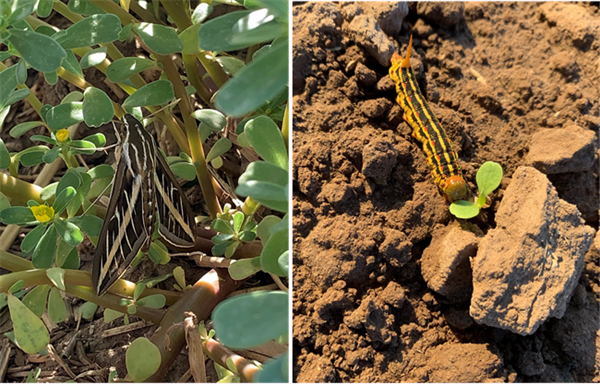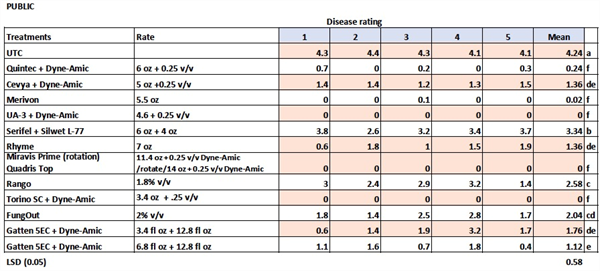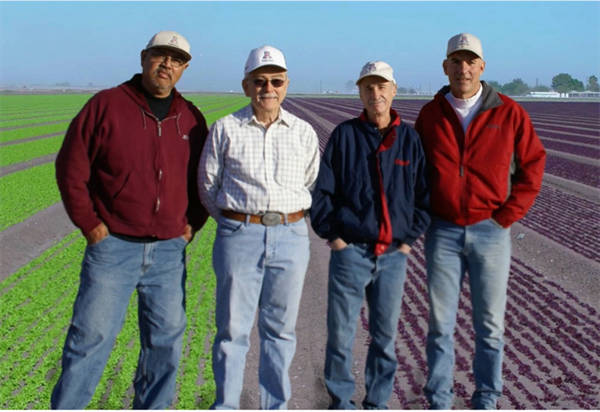-
Sep 21, 2022Hornworm Migrations onto Desert Produce Crops
By now you may have either experienced or heard about the unusual migration of hornworms occurring in Yuma, and particularly in the Dome/Wellton/Tacna areas. This is a first for me and is reminiscent of the mass migrations of saltmarsh caterpillars (“woolyworms”) out of cotton and onto seedling lettuce that was common in the 1990’s. However, in this case, the larvae of the whitelined sphynx moth, Hyles lineata, are dispersing into fields of seedling lettuce, broccoli, cabbage, and cauliflower from purslane (Portulaca spp.) found in nearby fallow fields. PCAs have reported that these migrations are occurring following desiccation of the purslane from herbicides, or after the hornworms have defoliated the plants (see VIDEO 1). This makes perfect sense as purslane is one of H. lineata’spreferred hosts. PCAs have documented larvae desperately moving across ditches, which if filled with water appear to be an effective barrier to their movement (see VIDEO 2a and VIDEO 2b; IMAGE 1). Based on published reports, hornworms usually limit their feeding to purslane and other desert vegetation, only moving into crops when their preferred host plant (i.e., purslane) is destroyed or consumed. When this occurs, larvae may try to feed on nearby plants. Hornworms in other parts of the country have reportedly caused damage to vegetable crops including cantaloupes, lettuce, turnips, and watermelons, but the damage is largely anecdotal, based on larvae seeking shade under or nibbling on leaves. There are no published studies of H. lineata larvae completing development on leafy or brassica vegetables.
However, the question remains for desert PCAs: will large numbers of starving hornworms moving into produce fields damage lettuce and brassica seedlings? Over the past week, I’ve had over 2 dozen calls and texts from PCAs discussing that question. To date, feeding or damage on emerging lettuce or broccoli seedlings has not been reported, despite the presence of large numbers of larvae on the beds and in furrows. However, feeding by hornworms on green cabbage and red savoy cabbage transplants was reported this weekend (see VIDEO 3; IMAGE 2) in Dome Valley. Incidentally, the PCA determined the feeding damage to be significant and quickly solved the problem with an application of Radiant and Asana.
So, what’s a PCA to do when confronted with large numbers of hornworms entering their produce fields. First, when in doubt…scout. Keep a daily, or even hourly, watch on the larvae and quickly decide whether they are just passing through (VIDEO 4) or are feeding and potentially damaging the plants. Seedling plants can tolerate very little feeding by large Lep larvae of any species before economic damage occurs. Thus, if you see significant hornworm feeding damage to plants and decide that control is warranted, a foliar application is likely you best bet. Several reports from PCAs indicate that pyrethroids are effective against hornworms when chemigated (IMAGE 3). If you choose to treat larger plants, insecticide products used to control armyworms and loopers should provide effective control. With beet armyworm becoming more abundant now, spraying may be easily justified. It is unknown whether an insecticide bait would be effective.
Special thanks to the following PCAs for sharing experiences, images and videos: Matthew Philips, Brian Johnson, Scott Fox, Bill Fox, Dan Fox, Scott McKenna, Steve Jensen, Eric Driedger, Dwight Palmer, JonHenry Luke and Mike Shugg. To contact John Palumbo go to: jpalumbo@ag.Arizona.edu
To contact John Palumbo go to: jpalumbo@ag.Arizona.edu



















